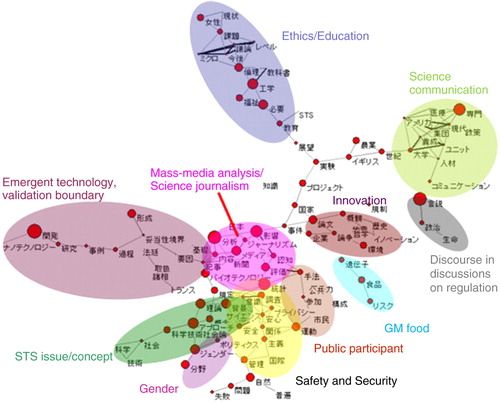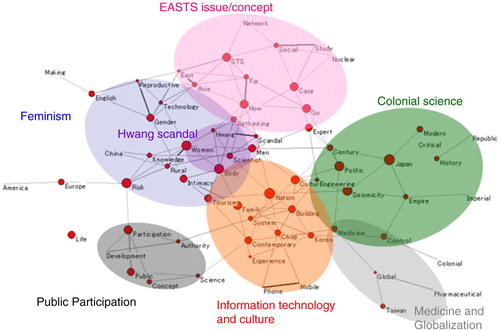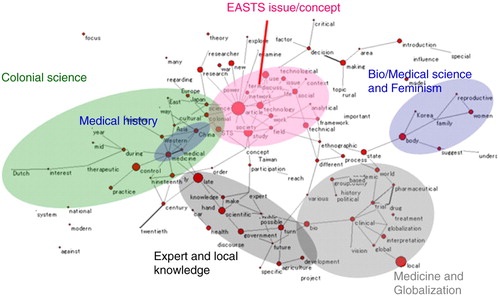Abstract
Currently, a new STS field, East Asian Science, Technology and Society (EASTS), has been developed. However, the EASTS perspectives have not been clear. In order to develop EASTS, it is necessary to understand each other more for much active STS in East Asian Community. Thus, we examine the current situation of EASTS by conducting a network analysis on highly frequent keywords in two STS journals. The results exhibited different tendencies observed in topics and fields even between the two STS journals' community. In East Asia, we should enhance our mutual understandings through STS, with reserving language/cultural diversity, and this is one of the challenges for East Asian STS community. So we have asked East Asian colleagues to participate in our project to figure out the characteristics of East Asian STS and asked them for suggestions and ideas for future collaboration.
Daiwie Fu (Citation2007) made several points regarding the development of East Asian science, technology, and society (EASTS):
East Asian STS will offer fresh STS perspectives because of its special local experiences, shared cultural and colonial histories, similar geological and meteorological makeup, and similar global positions (p. 13)
EASTS studies are indeed different from simply applying Western STS perspectives to East Asian ‘area studies’ (p. 5)
Fu also mentioned the importance of social practice and local contexts for science and technologies in East Asia:
…in contrast to super-rich, modern technologies, in East Asia we might like to pay more attention to the appropriate, the small, and the creole (p. 12)
According to Fu, EASTS should not be the mere application of western science, technology, and society (STS) to East Asian cases and should be a provider of fresh perspectives that take into consideration the practices of local context.
Many STS scholars agree that EASTS is not the mere application of western STS theories and accept the value of development of new frameworks. However, we need to specify the questions such as “What is an East Asian perspective?” and “What is the first step for action?” STS has spread rapidly, and at the same time each research community has set up its own journals and organizations/institutions embedded in their own culture.
To foster deeper mutual understanding and distinguish between each community's characteristics, a team from STS Network Japan (STSNJ) would like to present a proposal for an East Asian STS comparative research project. STSNJ is one of several STS research groups in Japan and was established in 1990 by Hideto Nakajima and his colleagues. STSNJ is a separate organization from the Japanese Society for Science and Technology Studies; NJ is an organization for information sharing and an arena for discussion, particularly for young STS scholars. On the basis of this network, we hope to establish an East Asian network, particularly of young researchers.
Our proposal is to carry out comparative research on each community's STS research by means of qualitative/quantitative analysis. One comparative example is discussed in this report, and it is the result of an analysis of the Japanese STS journal and the EASTS journal.
1 Method and Target of Analysis
The purpose of this analysis is to distinguish the tendencies and characteristics of each community's research in STS.
In this analysis, the Japanese and the EASTS journal were considered. The Journal of Science and Technology Studies (JSTS) has been published annually since 2002, mostly in Japanese. So far, seven issues containing 131 articles, including 22 book reviews, have been published. The EASTS Journal was first published in 2007. Eight issues have now been published, containing 93 articles, including 31 book reviews, excluding online first articles. All articles are written in English, and abstracts in several languages are attached.
In this report, we conducted network analysis focused on the co-occurrence of keywords (co-words) in article titles and abstracts, in order to grasp topics, keywords in context, and the relationships between topics and keywords. Although several problems have been discussed in previous studies (CitationLeydesdorff 1997), co-words and the network structure of co-words have been widely recognized as carriers of meaning and indicators of words in context (Callon et al. Citation1983, Citation1991; CitationStegmann and Grohmann 2003; Leydesdorff and Hellsten Citation2005, Citation2006). In addition, words in titles and abstracts represent contents and can be seen as the identification markers of articles (CitationMullins et al. 1988; CitationBraam et al. 1991). The method of network analysis in this report depends on previous studies by Leydesdorff and Hellsten (Citation2005, Citation2006). In this analysis, Salton's cosine, which is one of the major similarity indexes, was calculated as the similarity index (CitationSalton and McGill 1983; CitationJones and Furnas 1987). Networks are described by Pajek (Batageli and Mrvar 1998). The visualizations are based on the Kamada and Kawai (Citation1989) algorithm. Centrality was shown based on betweenness (CitationFreeman 1979).
The frameworks and target scientific fields of each article were also investigated, in order to interpret our results and provide additional indicators.
2 Biases and Limitations
First, there may be a bias arising from special feature issues. For example, the JSTS journal featured “science communication” in volume 5 and “nanotechnology” in volume 6. However, the choice of topics can be regarded as representative of each STS community.
Second is the limited number of journals compared. In this report, only two journals were analyzed. We can point out some trends, but excessive generalization should be avoided. In order to hold comprehensive view of STS in East Asian, the characteristics of other journals also in Taiwan, Korea, and China should be analyzed, and we ask STS-ers from each community to take part in our comparative project. This report is a first step for further discussion.
Third is a technical matter. In quantitative text analysis, several preparations for analysis are important, including making corpus, unification of words, and stemming. Although we conducted some preparations, such as rewording from plural to singular, this remains at a rough level.
Even though there are some limitations, we believe it offers an outline for comparison.
3 Results
illustrates a network analysis, focusing on keywords in titles, of the JSTS journal. In this analysis, the top 109 keywords, which appeared more than twice in titles of the whole article set, including book reviews, were selected as variables. For the analysis of titles in the JSTS journal, the threshold of cosine was set to 0.37.
It was found that there are recurring topics: “STS: issue/concept,” “emergent technology, validation boundary,” “mass media analysis/science journalism,” “gender,” “public participation,” “safety and security,” “gm food,” “innovation,”
Fig. 1 Cosine map of 109 words used more than twice in JSTS article titles (cosine≥0.37)

Fig. 2 Cosine map of 67 words used more than twice in EASTS article titles (cosine≥0.35)

illustrates a network analysis, focusing on keywords in titles, of the EASTS journal. In this analysis, the top 67 keywords that appeared more than twice in titles of the whole article set, including book reviews, were selected as variables. For the analysis of titles in the EASTS journal, the threshold of cosine was set to 0.35.
It was found that the following are regular topics: “EASTS: issue/concept,” “colonial science,” “feminism,” “Hwang scandal,” “public participation,” “information technology and culture,” and “medicine and globalization.”
A network analysis of keywords in abstracts was also conducted for the EASTS journal, in addition to the analysis of keywords in titles (). In this analysis, the top 124 frequent keywords, which appeared over three times in abstracts, were selected as variables. For the analysis of abstracts in the EASTS journal, threshold of cosine was set 0.515.
Considering the results of Figs and , it was found that issues related to keywords such as the body, gender, and women appeared with the topics on “bio/medical science” (e.g., Hwang scandal, reproductive technique). Interestingly, this indicates that “bio/medical science” was discussed in the context of “feminism” and vice versa. The theme concerning “expert and local knowledge” was discussed in the context of public participation in some cases, and several investigations of medical history were conducted as colonial science studies. The topics “medicine and globalization” and “colonial science” are also found in this analysis of keywords in abstracts.
4 Summary and Discussion: Differentiators and Commonalities
The result of our comparison of the contents of the JSTS and the EASTS journal is summarized in .
A variety of topics on advanced sciences (nuclear power, nanotechnology, etc.) can be pointed out as a defining feature of the JSTS journal. Conversely, discussions of mass media analysis (particularly on quantitative analysis) and science journalism are not seen in the EASTS journal. The JSTS journal lacks articles on historical research and investigations of colonial science. One possible reason for the lack of historical studies may be a local division of labor with the History of Science Society of Japan. At the same time, the discussion of feminism and postcolonial STS are minor topics in the JSTS journal. In JSTS volume 7, a special topic “women and science” was featured, the articles were largely limited to gender biases in science, such as the ratio of women scientists.
The EASTS journal exhibits a richness of historical studies of colonial science, and several ethnographic studies to investigate local knowledge were observed as part of this historical approach; the richness of content on “bio/medical science” connected to keywords such as feminism, the body, family, and globalization. There are few mass media analyses, science journalism, or quantitative surveys.
The two journals do share a common direction such as “public participation,” “local knowledge,” “actor network theory,” etc. However, these are considered to be common not only in the East Asian, but also in the global STS. Tsukahara (Citation2009) suggested that this situation in Japan was a symptom of the colonial and Western-dependent character of intellectuals. This links in with Fu's position that EASTS aims not just to apply Western STS perspectives to Asian cases (CitationFu 2007). Therefore, directions for establishing East Asian perspective should continue to be discussed.
5 Proposals
We have demonstrated different tendencies between the JSTS and the EASTS journal, and we call for research cooperation for the investigation of the STS journals of other Asian communities and for more comprehensive discussions. For future effective cooperation, STS's own reflexivity, and the enhancement of our mutual understanding through STS and the establishment of East Asian Community, it will be essential to add analyses of the STS journals of the Korean, Taiwanese, and Chinese research communities. Comparison of these journals will more vividly show the features of each STS culture and community in the East Asia region.
Difference does not always mean incongruity. In our opinion, the differences made us richer with diversity and it actually provides us with an opportunity for cooperation, using each other's strong points effectively. Active cooperation between STS scholars in East Asia will provide more fruitful insights into both EASTS and indigenous STS perspectives.
For future cooperation, the 35th 4S Annual Meeting will be held in Tokyo in August 2010. It will be an opportunity to consider “What is East Asian STS?”;we would like to call for collaboration with our East Asian STS colleagues.
Acknowledgment
This report is based on a presentation at the 4th East Asian STS Young Scholar's Workshop 2009, in Kobe. In the workshop, we received valuable comments from Prof. Song Sang-Yong, Prof. Hideto Nakajima, and Prof. Wen-Hua Kuo. The proposals in this report for future cooperation were designed by the STS Network Japan.
References
- Batagelj V. Mrvar A. (1998). Pajek—A program for large network analysis. Connections, 21(2), 47–57.
- Braam R. R. Moed H. F. van Raan A. F. J. (1991). Mapping of Science by Combined Co-Citation and Word Analysis. I. Structural Aspects. Journal of the American Society for Information Science, 42 (4), 233–251.
- Callon M. Courtial J. P. Laville F. (1991). Co-word analysis as a tool for describing the network of interactions between basic and technological research: The case of polymer chemistry. Scientometrics, 22(1), 155–205.
- Callon M. Courtial J.-P. Turner W. A. Bauin S. (1983). From translations to problematic networks: An introduction to co-word analysis. Social Science Information, 22, 191–235.
- Freeman L. C. (1979). Centrality in social networks conceptual clarification. Social Networks, 1(3), 215–239.
- Fu D. (2007). How far can East Asian STS go? A position paper. EASTS, 1(1), 1–14.
- Fujigaki Y. (2003). The public ethic and the spirit of specialism. Tokyo: University of Tokyo Press.
- Jones W. P. Furnas G. W. (1987). Pictures of relevance: A geometric analysis of similarity measures. Journal of the American Society for Information Science, 36(6), 420–442.
- Kamada T. Kawai S. (1989). An algorithm for drawing general undirected graphs. Information Processing Letters, 31(1), 7–15.
- Leydesdorff L. (1997). Why words and co-words cannot map the development of the sciences. Journal of the American Society for Information Science, 48(5), 418–427.
- Leydesdorff L. Hellsten I. (2005). Metaphors and diaphors in science communication: Mapping the case of ‘stem-cell research’. Science Communication, 27(1), 64–99.
- Leydesdorff L. Hellsten I. (2006). Measuring the meaning of words in contexts: An automated analysis of controversies about ‘Monarch butterflies’, ‘Frankenfoods’, and ‘stem cells’. Scientometrics, 67(2), 231–258.
- Mullins N. Snizek W. Oehler K. (1988). The structural analysis of scientific paper. In Van Raan A. F. J (Ed.), Handbook of Quantitative Studies of Science & Technology (pp. 85–101). Amsterdam: Elsevier Science Publishers.
- Salton G. Mcgill M. J. (1983). Introduction to modern information retrieval. Auckland: McGraw-Hill.
- Stegmann J. Grohmann G. (2003). Hypothesis generation guided by co-word clustering. Scientometrics, 56(1), 111–135.
- Tsukahara T. (2009). Introduction (1): Japanese STS in Global, East Asian, and Local Contexts. EASTS, 3, 505–509.

